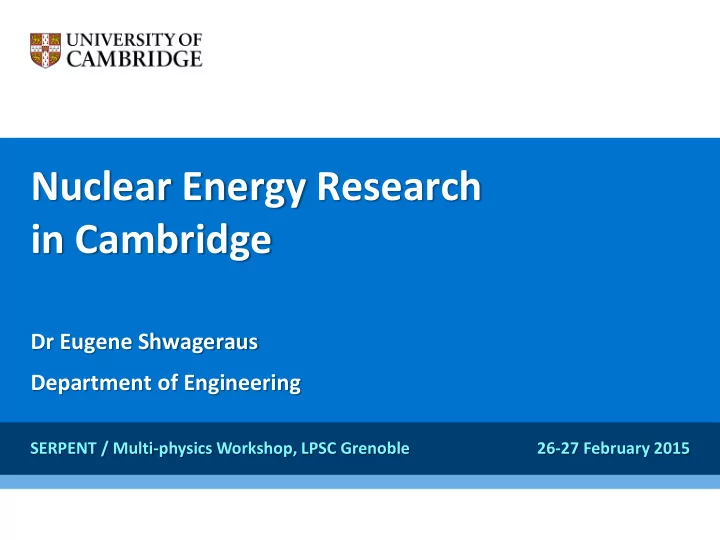

Nuclear Energy Research in Cambridge Dr Eugene Shwageraus Department of Engineering SERPENT / Multi-physics Workshop, LPSC Grenoble 26-27 February 2015
Nuclear Energy Education in Cambridge Undergraduate Introduction to NE, Nuclear Materials, Reactor Engineering, Advanced Systems/Fusion, Medical Physics Over 150 students took NE introductory module last year 10 – 20 fourth-year Engineering Projects were offered Graduate NE MPhil – one year full time masters course 15 PhD students in Engineering/Physics, Waste/Materials and Business/Policy Centre for Doctoral Training (CDT) – jointly with OU and ICL 2
Nuclear Energy Research Community in Cambridge Cambridge Nuclear Energy Centre Coordinates cross-discipline collaboration About 15 academics are actively engaged in NE related research o Department of Engineering: Physics and design of advanced systems o Department of Earth Sciences and Department of Materials Science & Metallurgy: Waste and decommissioning, high temperature reactor materials, fuel reprocessing, fracture mechanics and steels o Judge Business School: Economics, technology policy 3
MPhil in Nuclear Energy - Overview Taught 1 year MPhil in Nuclear Energy (runs October – August each year) 20 -25 top students from around the world each year 5 core nuclear engineering modules Nuclear policy module Elective modules from Engineering, Materials Science, Chemical Engineering, Physics and Judge Business School 4 months project on either: o Cambridge University or o Industry partner research topic 4
Nuclear Energy MPhil - Core Scope Core Topic Scope Core physics & shielding – steady state power & shapes, depletion Reactor Physics control elements & use of poisons, core kinetics & system control. Coolant types, thermal cycles, heat transfer, thermal limits – reactor Reactor Engineering & Heat systems, their optimisation and operating characteristics including Transfer normal operation & how to address main types of fault condition. Fuel Cycle, Waste & Whole fuel cycle: mining to waste & how waste is managed, decommissioning principles. Decommissioning Fuel and reactor materials – including selection, safety and life issues Fuel & Reactor Materials – radiation behaviour & damage, structural integrity & fracture mechanics, EAC. Safety philosophies, impact on design, justification approaches, Safety & Advanced Systems control & reliability, advanced systems including Gen IV, Thorium & Fusion Energy studies & climate change, economics of energy, nuclear Nuclear Technology Policy politics, proliferation & physical security. 5
MPhil – Breadth & Depth of NE Education Breadth: o Teaching a wide range of nuclear engineering and policy topics o Visits & experiments: Sizewell B, Culham Fusion R&D lab, Research Reactor o External lectures by leading figures from the nuclear industry Depth: o Choice of optional/elective courses o Long research project and dissertation o Projects from industry – on a real issue with supervision by industry 6
Examples of MPhil Projects Title Student WIMS/ PANTHER model for a start-up EPR Core Jinfeng LI Economics of SMRs – design options Inkar Yertayeva Managing power peaking at fissile-fertile interface in HC LWRs Cuicai Dong Ethical Principles & Values in Nuclear Safety Annie Bonaccorso Accelerator Production of medical isotopes Tianyi Wang Commercial Nuclear Marine Core Design Hao Sun Electron Beam welds in nuclear pressure-vessels Chris Duffy Waste glass dissolution modelling Rui Guo Modelling of Fast Reactor transients Xinyu Zhao Energy group structure optimisation for fusion reactor applications Michael Fleming 7
Examples of using Serpent Seed-blanket interface multi-physics modelling 8
Examples of using Serpent ABWR modelling Serpent XS + PANTHER Thermal feedbacks included 9
Examples of using Serpent EPR startup core modelling WIMS/Serpent XS + PANTHER Thermal feedbacks included This work ONR report Difference Critical Boron Concentration (ppm) 1029 1026 0.3 % Total Heat Flux Hot Channel Factor 2.69 2.82 -4.8 % Hot Channel Factor 1.63 1.61 1.2 % Doppler Coefficient BOC -2.90 -2.93 1.0 % (pcm/K) EOC -3.17 -3.21 1.2 % MTC BOC -13.7 -13.0 5.4 % (pcm/K) EOC -64.2 -60.6 5.9 % Boron Worth BOC -9.1 -9.3 2.2 % (pcm/ppm) EOC -9.4 -9.7 3.1 % 10
Examples of using Serpent Multi-physics modelling of fusion breeding blankets 11
Examples of using Serpent HEU to LEU fuel conversion of CONSORT reactor 12
High Conversion LWRs Modelling Highly heterogeneous cores Analysis methods Monte Carlo XS + nodal diffusion codes for transients Coupled Monte Carlo – multi-physics • Accelerated convergence and numerical stability SP3 option in DYN3D 3D MoC – WIMS/CACTUS Dynamic modelling of fuel cycle systems 13
Molten Salt (and Molten Salt-Cooled) Reactors Real potential to compete with LWRs economically High temperatures for non-power applications Hybrid systems to complement fossil fuels and renewables Design space remains largely unexplored Fast/thermal, Pebbles/blocks, SMR/large Ongoing collaboration with MIT-UCB-UW Joint NEUP proposal submitted 14
LWR Core Design Stochastic fuel loading optimisation algorithms Advanced PWR/BWRs with exotic fuels I2S-PWR project Accident tolerant fuels Thorium/Pu/MA Transients and steady state WIMS/PANTHER/DYN3D PARCS-TRACE 15
Fast Reactors Once-through Fast Reactors (no reprocessing) A.K.A Traveling-Wave, Breed & Burn, USFR etc. Passive safety (DHR and reactivity control) High leakage “Pancake” shape is no longer needed Cheaper, more neutronically efficient core Core disruptive accidents Tightly coupled problems - OpenFOAM ? Thorium fuel cycle for Fast Reactors EPSRC UK – India Civil Nuclear Collaboration Proposal submitted 16
Thank you 17
Recommend
More recommend